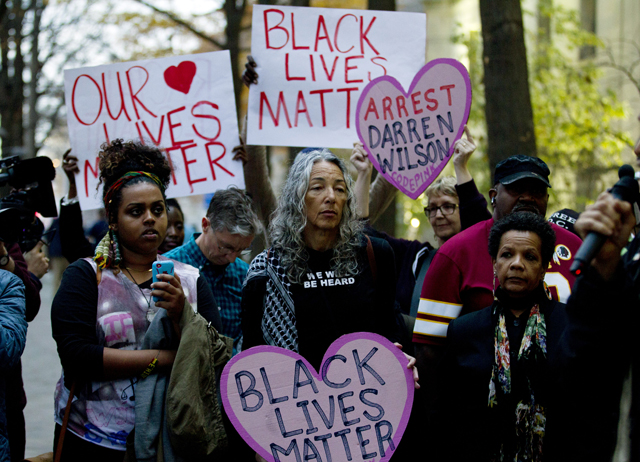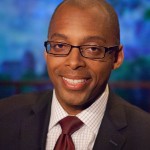This post first appeared at The Nation.

Demonstrators protest against the shooting of Michael Brown, during a rally at the Department of Justice in Washington, Monday, Dec. 1, 2014. A grand jury in Ferguson, on Monday, Nov. 24, 2014, declined to indict police officer Darren Wilson in the shooting death of Brown, an unarmed black man. Protesters across the USA have walked off their jobs or away from classes in support of the Ferguson protesters. (AP Photo/Jose Luis Magana)
Truth is stranger than fiction; it is also most certainly harder to accept.
In a nearly hour-long interview with ABC’s George Stephanopoulos on Tuesday, a day after thousands of protesters took to the streets from coast to coast, expressing outrage that yet another white police officer got away with the murder of another unarmed black person, Wilson stuck to his story: “I just did my job. I did what I was paid to do. I followed my training…. That’s it.”
And yet, despite all the equivocations, the shooting death of the teenager on August 9 and last Monday’s grand jury decision not to indict Wilson were entirely unsurprising. They are the predictable outcomes of a criminal justice system doing exactly what it was meant to do. For all the dissecting and debating of the veracity of Darren Wilson’s grand jury testimony this week, one thing seems crystal clear. He was in fact doing his job.
Indeed, by this standard, isn’t Darren Wilson actually a model police officer?
He certainly thinks so. When asked by Stephanopoulos if he could make “something good” come of this experience, he said he would “love to teach people” and give them “more insight in uses of force.” That he may have logged more time on first-person shooters — emptying clip after clip to take down demonic super-villains who “run through shots” — than actual police work is beside the point. Darren Wilson has the kind of experience that many Americans value.
Evidence abounds that the United States is the world’s most punitive nation. More people are behind bars and incarcerated at higher per capita rates here than anywhere in the world. African-Americans are the nation’s prime suspects and prisoners. White police officers are our chosen protectors, enforcing the law in the name of public safety.
In a Pew research poll conducted shortly after Ferguson made national headlines this summer, researchers found that most Americans have a “fair amount of confidence in local police.” Eighty-five percent of respondents, white and black, gave a fair to excellent rating on police “protecting people from crime.” And on “using the right amount of force,” 66 percent of respondents gave a fair to excellent rating; white support stood at 73 percent and blacks at 42 percent. Though a clear racial divide exists, African-Americans are only 13 percent of the population nationally. Everyone is therefore implicated in police performance writ large, if not by choice, certainly through political representatives.
Critics and protesters of police violence among African-Americans and on the political left, as polling data suggests, see things differently. They are organizing against the routine killing of unarmed men and beating of helpless women on an unprecedented scale not seen since the anti-lynching movement of the last century. Even with such evidence in hand that black men are 21 times as likely to be killed by law enforcement than white men, as analyzed in a recent report by ProPublica, today’s movement like the one before it might fail to overcome deeply entrenched fears of black criminality without a massive shift in white public opinion and a new model for law enforcement.
Most whites do not realize they are reading from very old racial scripts. When Ida B. Wells, the world’s leading anti-lynching activist and black social worker of the early twentieth century, tried to explain to a wealthy suffragist in Chicago that anti-black violence in the nation must end, Mary Plummer replied: Blacks need to “drive the criminals out” of the community. “Have you forgotten that 10 percent of all the crimes that were committed in Chicago last year were by colored men [less than 3 percent of the population]?”
Like Mary Plummer, Darren Wilson is emphatic that the issue is not racism. Brown’s African-American neighborhood is “one of our high-crime areas for the city,” he said during the interview. “You can’t perform the duties of a police officer and have racism in you. I help people. That’s my job.” On that day, “the only emotion I ever felt was fear,” before my training took over. “We are taught to deal with the threat at hand.”
Implicit bias research tells us that most Americans are afraid of black people and subconsciously associate dangerous weapons and animals with them. They see things often that are not there. Stanford psychologists Rebecca Haley and Jennifer Eberhardt note in a study last month that the more people perceive blacks as criminals or prisoners, “the more people fear crime, which then increases their acceptance of punitive policies.”
The truth is that Wilson has no regrets. He wouldn’t do things differently. He’s looking forward to a new chapter in his professional journey as a teacher, trainer or a consultant. He’s our representative figure — a model policeman — acting on our collective fears.
The views expressed in this post are the author’s alone, and presented here to offer a variety of perspectives to our readers.
Watch Bill’s interview with Khalil Muhammad on Facing Our Racial Past.


